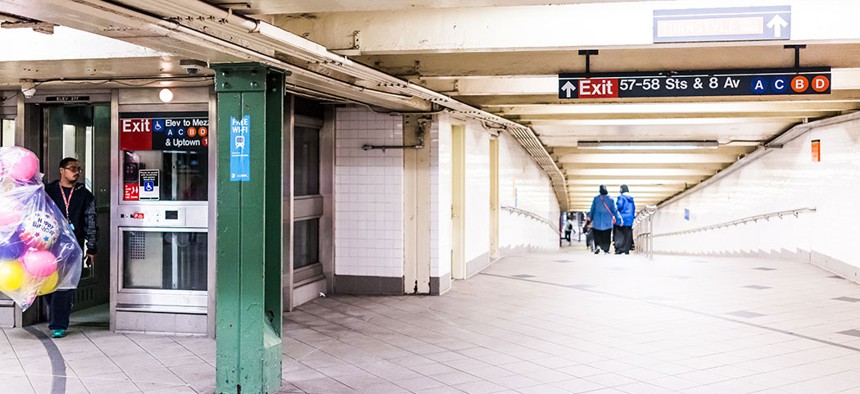New York City
Why is subway accessibility so expensive?
It’s not just about installing new elevators.

A subway elevator. Kristi Blokhin/Shutterstock
Seventy-eight million dollars can buy more than 2,000 wheelchair-accessible buses, a mile of new subway line in Madrid or 240 Andy Byfords for one year. Or, according to the Metropolitan Transportation Authority, $78 million will build new elevators in a single subway station.
The MTA’s 2020-2024 Capital Plan includes a $5.5 billion investment in building new elevators at 70 subway stations. As The New York Times pointed out this week, that averages out to an estimated cost of around $78 million per subway station. This certainly isn’t the first time the MTA’s price tags have prompted a double-take, as the total cost of their next five-year Capital Plan is a record-busting $54 billion.
Making 70 stations accessible to wheelchair-users is a small task, but when comparing New York’s estimated costs for accessibility upgrades to those of other cities in the United States and in major international cities, the extravagance of the MTA’s spending stands out.
As the MTA’s head of capital construction, Janno Lieber, told the Times, it’s not just the cost of elevator installation that goes into total estimates for adding elevators. In fact, Lieber said, the elevator itself accounts for only about 20% of the cost. Other work, including land acquisition costs and needing to move water and power lines, factors in.
Still, New York City isn’t unique in having to navigate existing utility infrastructure. “I can certainly say that London and Toronto and Paris also have running water,” noted Jonathan English, a Ph.D. candidate in urban planning at Columbia University. “Electricity too.”
In fact, New York’s accessibility renovations should be easier than other cities, some say. “When you compare New York's subway to most other subways in the world, these elevator projects should be much simpler than most of them,” English said, noting that other cities have subways further underground. “The New York subway, most of it is very shallow, it's literally just a roof with the street running over it.” And yet, Boston recently built three new elevators and two new escalators at a station for $36 million. Accessibility upgrade costs per station in European cities like Paris, Madrid and Berlin have been estimated at $22 million, $7.5 million and $2.6 million, respectively.
There’s not a lot of clarity around why exactly New York’s estimated average cost per station is somewhere between three and 30 times those of the above cities. Part of that has to do with the fact that few details have been made public about the MTA’s accessibility upgrades, apart from which stations the agency plans on tackling first. The MTA did not respond to a request for comment before publication.
Some transit experts speculate that what’s driving up the costs of building new elevators is that the MTA’s procurement process is largely uncompetitive. “They have really hyper-detailed specs for everything,” said Alon Levy, a transit writer and mathematician, of the MTA’s bidding process, noting that some requirements are meant to keep contractors from taking advantage of the agency. But that also results in fewer companies wanting or being able to deal with the MTA. “If there isn’t a lot of competition, the three companies that know how to deal with the MTA can charge a premium because they have a very specific skill – namely, knowing how to deal with the MTA,” Levy said.
Contracting with the MTA may result in a big payday, but for some companies it’s not worth it. “The MTA historically has been a tough partner to work with. And when you factor in the cost of bureaucratic delay, red tape, and project risk, some companies say, ‘No thanks,’” said Colin Wright, a senior associate at the transit advocacy group, TransitCenter.
Others ventured alternative theories that could play a role in raising the MTA’s construction costs in general, and could theoretically be at work in the upcoming elevator upgrades as well.
“Overall, I think one of the problems that seems to be driving costs in New York and in other cities is that you have a project that runs long and has a very big cost overrun,” English said. “Then when the next project comes along, you base the costs of that next project on the previous project. So this project that had a lot of delays now becomes the base cost. And then, because your previous project had a lot of delays, you then add a contingency – we won't go over budget this time because we'll add a 50% contingency because we had a 50% overrun last time. So rather than having a lesson learned – 'Okay, we made these mistakes, now we can do the second one much cheaper' – you end up having the mistake-ridden project's costs escalated further by that contingency.”
One explanation that comes up often for the MTA’s capital construction is the cost of labor – both in terms of employing more workers than necessary thanks to rules negotiated by politically powerful unions, and expensive pension and health care costs. “A lot of it is still prevailing wage and work rules,” Nicole Gelinas, a senior fellow at the Manhattan Institute, wrote in an email. “We do this work very inefficiently and expensively – we need to see the contracts between the MTA contractors and the private-sector union construction workforce.” Reporting by the Times showed that some explanation for the MTA’s expanding capital costs in some construction areas did have to do with excessive labor costs.
Transit experts and advocates are unsurprisingly in agreement that the MTA needs to lower these costs to something more akin with what other major cities in the United States, and across the country, are spending. “At the end of the day, we have no choice,” said Wright. “We need a fully accessible subway system and we need to be able to afford that.”

NEXT STORY: New York City Council contemplates banning biometric tech
